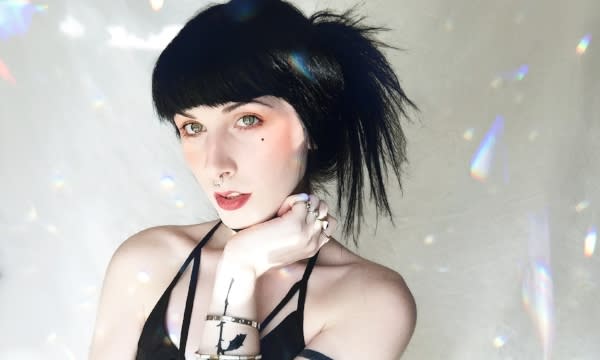Beyond the droning chorus of misogynistic think-pieces deriding selfie culture as vapid and narcissistic are the very real positive effects that a curated self-image can have on women, people of color, and LGBTQIA folks. For people pushed into the margins of dominant cultural narratives, self-love is a radical act of healing. Self-image as an autonomous vehicle for empowerment didn’t start with the front-facing camera, but with self-portraiture in art. The Venus of Willendorf, the voluptuous stone figurine dating back to 30,000 BC, is believed to be a self-portrait, a first-person view of a woman looking down at her own body. Like Artemisia Gentileschi, Frida Kahlo, and countless teenage girls with wild ambition and trembling hearts, JanieWhateva’s awakening as an artist began with self-portraiture.
“I started doing portraits in high school when I realized I was trans. I figured if I turned myself into art, I’d feel like a piece of art. It really helped me cope with the dysphoria I was feeling.” She then started doing portrait commissions for others to help them feel the same way. The transformative inward implications of a glowing selfie are as vital as the outward implications. Your confident self-image becomes a beacon for others who look, live, or feel like you. Visibility, like that portrayed in JanieWhateva’s brilliant LGBT-themed zodiac series for OutSmart Magazine, can be life-affirming.
When asked why she thinks astrology is so popular in the LGBTQIA community, Janie’s response is disarmingly thoughtful. “I believe it stems from having this part of us that we were never taught about. In whatever form that hole may take, it left us lacking knowledge about ourselves that we must seek out on our own while others are born into a society built for them. Growing up, I was never taught about the existence of the LGBTQ or our rich history, so I had to seek out things like horoscopes to figure out why I am the way I am.”
Janie’s a champion of representation and visibility, portraying different body types, races, and gender identities in her art. Witchy and moody, her drawings blur the lines between creepy and erotic portrayals of the occult. Part tribal, part celestial, part medieval hagiography, JanieWhateva’s work is like what the 2018 Met Gala tried to do with their theme “Heavenly Bodies: Fashion and the Catholic Imagination” crossed with a David Lynch-ian fever dream.
Furthering the supernatural vibe is Janie’s next project: completing her own tarot deck, card by card. With 70 unique cards down, she’s less than a dozen cards away from a full deck, available soon for preorder. Like many self-run creative small businesses, JanieWhateva hustles to fund her passions but doesn’t let that—or material success—define her. Janie’s refreshing advice to budding artists is clearly a mantra she meditates on herself. “Your success is not your worth. Your value is not represented by a dollar sign. Your desire to put beauty into the world is what defines you to your core.”
Even if that beauty started as a really killer selfie.


 Credit: JanieWhateva
Credit: JanieWhateva
